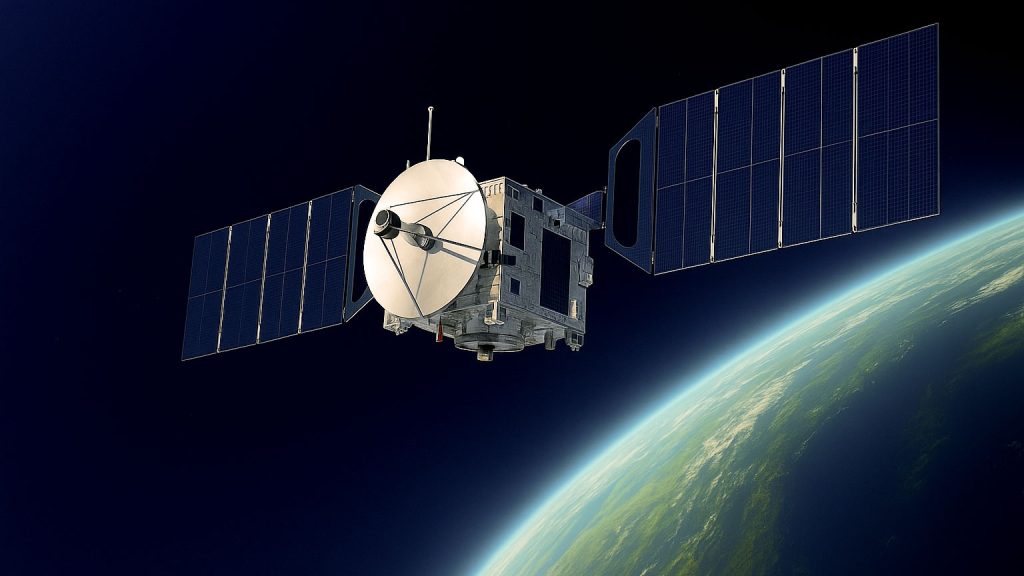- SpaceX deployed 5,000 Starlink terminals to Ukraine within days of the 2022 invasion, rising to about 15,000 active terminals by June 2022, with Ukraine at one point accounting for roughly 58% of global Starlink traffic.
- Russia attempted to jam Starlink signals on the battlefield, SpaceX rolled a software update to bypass the jamming, and by 2023–2024 reports noted illicit Starlink terminals in Russian hands that had to be disabled.
- On February 24, 2022, Russia launched a cyberattack against Viasat’s KA-SAT network that crippled thousands of Ukrainian modems and disrupted satellite links across Europe.
- In August 2022, Ukraine crowdfunded $20 million to lease an ICEYE SAR satellite for a year, and by mid-2024 this enabled over 4,600 reconnaissance missions and contributed to hits such as the Rostov-on-Don submarine and the Minsk landing ship.
- Ukraine had no indigenous spy satellites at war start, but benefited from US/NATO imagery and commercial firms like Maxar and Planet, with KH-11 Keyhole optical satellites reportedly delivering 5–10 cm resolution and a dedicated intelligence-sharing cell coordinating feeds.
- Russia’s space-based reconnaissance was limited, with only a handful of high-resolution optical satellites (perhaps two Persona) and one older Kondor radar satellite active in 2014, while May 2023 saw the Kondor-FKA SAR launch and late-2024 another new radar satellite.
- Maxar’s WorldView images captured the February 2022 40-mile convoy near Kyiv, and Planet imagery helped track Russian deployments and massing in Belarus.
- Ukraine unveiled the Piranha electronic warfare system to suppress GLONASS signals within a 600-meter bubble, with field tests reported and plans for mass production.
- U.S. Space-Based Infrared System (SBIRS) sensors detect missile launches from space in seconds, providing warnings that helped Ukraine cue air defenses against Kinzhal launches and Shahed drone swarms.
- In November 2021 Russia conducted a direct-ascent ASAT test destroying an old satellite in low Earth orbit, signaling the capability to strike space assets, though the war has seen no kinetic ASAT use and both sides rely on non-kinetic means like jamming and hacking.
The war in Ukraine is not just being fought on land and in the skies – it’s also being waged in orbit. Since the full-scale invasion in 2022, both sides have leaned heavily on military satellite services for communication, intelligence, navigation, targeting, and early warning. From SpaceX’s Starlink internet constellation keeping Ukrainian forces online to Russian reliance on GLONASS navigation, satellites have become game-changers in modern warfare. Below, we break down the key satellite services deployed by Ukraine, Russia, and their allies, the platforms and players involved, and how space-based technology is influencing the course of the conflict – all backed by publicly documented sources.
Satellite Communications: Linking the Frontlines
Robust communication is the nervous system of any modern military, and Ukraine turned to satellite communications to maintain its wartime network. Within days of the invasion, SpaceX sent an initial batch of 5,000 Starlink terminals to Ukraine, providing off-grid high-speed internet via its constellation of low-Earth orbit satellites [1]. By June 2022, that number had tripled to about 15,000 active Starlink terminals, enabling critical command-and-control and keeping civilians online even as Russian strikes knocked out cell towers and power grids [2] [3]. At one point, roughly 58% of global Starlink traffic was coming from Ukraine – a testament to how heavily the country leaned on the system in wartime [4].
Starlink’s impact on Ukraine’s military operations is hard to overstate. The encrypted satellite links allowed Ukrainian units to coordinate even when traditional comms were disrupted. Frontline troops use Starlink to transmit video from drones, call in artillery fire, and share intelligence in real time [5] [6]. Government services and civilian populations in besieged cities also stayed connected via Starlink when terrestrial internet was down [7]. Ukraine’s Minister of Digital Transformation Mykhailo Fedorov noted that Starlink became the backbone of Ukraine’s communications, proving “a reliable partner” that substituted for destroyed fiber lines and cellular networks [8]. Volunteers even learned to repair damaged Starlink dishes from shrapnel or voltage surges to keep the distributed network online [9].
Russia, recognizing the threat, attempted to jam Starlink signals on the battlefield. In fact, just days into the war, SpaceX CEO Elon Musk reported that “Starlink terminals near conflict areas were being jammed for several hours at a time” by Russian electronic warfare units [10]. SpaceX quickly responded with a software update that successfully bypassed the jamming efforts [11], showcasing the agility of commercial space tech in a combat environment. Later in the war, Russian forces also tried to intercept or hack Starlink, prompting SpaceX to harden its cyber defenses [12] [13].
However, Ukraine’s heavy reliance on a private company’s satellites has come with complications. Elon Musk at times raised concerns about Starlink’s use in offensive operations, given SpaceX is a civilian company. On multiple occasions in 2022–2023, Musk threatened to curtail Ukraine’s Starlink access or refused certain uses – for example, geofencing the service to prevent Ukrainian drones from using Starlink over Russian-occupied Crimea or the Black Sea [14]. In early 2023, SpaceX did in fact limit Ukraine’s ability to use Starlink for controlling long-range naval drones, illustrating the influence a CEO can wield over military communications [15]. Each time, these incidents sparked alarm about Ukraine being at the mercy of a private actor for a critical service.
Notably, Russia has also acquired Starlink terminals on the black market. Reports emerged in 2023–2024 that Russian troops managed to obtain “illicit” Starlink units and use them for their own communications, apparently by circumventing usage restrictions [16]. This prompted the Pentagon and SpaceX to work on identifying and disabling those rogue terminals [17]. Ukraine criticized Musk for not blocking Starlink usage in occupied territories, but officially Starlink says it has never authorized service for Russia [18] [19]. The cat-and-mouse game underscores how Starlink has become a dual-edged tool on the battlefield, empowering Ukraine’s warfighting while presenting novel ethical and security dilemmas.
Beyond Starlink, the war opened a new front in space-based cyber warfare. In a brazen opening salvo on February 24, 2022 (the morning of the invasion), Russia launched a cyberattack against Viasat’s KA-SAT satellite network, which Ukraine’s military was using for high-bandwidth communications [20]. The attack crippled thousands of Viasat modems across Ukraine and even knocked out satellite internet service in other European countries. This satellite hack disrupted Ukrainian command networks at a critical moment [21]. Western officials later attributed it directly to Russian state-backed hackers and noted it as one of the first major cyberattacks of the war [22]. Ukraine scrambled to restore connectivity – and the rapid deployment of Starlink was, in part, a response to fill the communications gap left by the Viasat outage [23] [24].
Russia’s own military communications satellite infrastructure, by contrast, has shown limitations. Analysts note that Russia entered the war with an aging and inadequate fleet of communications satellites, some dating to Soviet-era designs [25] [26]. Many Russian units in Ukraine were forced to rely on insecure radios and even cell phones – with dire consequences. Intercepted phone calls by Russian soldiers provided intelligence to Ukraine, and some poorly-secured comms were geolocated and targeted for strikes [27] [28]. While Russia does have military relay satellites (such as the Meridian series), Western sanctions have made it hard for Moscow to replenish or upgrade its space assets [29] [30]. This contributed to “communication breakdowns” in Russia’s campaign [31] [32]. Indeed, Russia’s struggles to coordinate far-flung units have been partly blamed on its meager satellite comms capacity.
In short, controlling the information pipeline via satellites has been pivotal. Ukraine’s savvy use of commercial satellite internet – effectively crowd-sourcing a space-based military comms network – gave it a resilient edge in the information war. Russia, having tried and failed to knock out that network, now faces an adversary whose troops can communicate securely no matter what jamming or bombing campaign is thrown at them. And as we’ll see next, connectivity is only one piece of the orbital puzzle; seeing the battlefield from above is just as crucial.
Eyes in the Sky: Satellite Reconnaissance & ISR
Timely intelligence is the backbone of effective military operations, and in Ukraine much of that intelligence comes from satellite-based ISR (Intelligence, Surveillance, Reconnaissance). Ukraine does not own a large spy satellite constellation of its own, but it has benefited immensely from an unprecedented level of support from allied and commercial satellites. Meanwhile, Russia’s traditional dominance in space spying has been undermined by swift Western data-sharing and agile private-sector imaging.
United States and NATO intelligence satellites have effectively been “on Ukraine’s side” throughout the conflict. Within days of the invasion, the U.S. and its allies began providing Ukraine with near-real-time satellite imagery and geospatial intelligence on Russian troop movements [33]. This included data from America’s most powerful classified spy satellites – such as the KH-11 Keyhole electro-optical satellites (with resolutions reportedly as fine as 5-10 cm) – and radar imaging satellites that can see at night and through clouds. The U.S. reportedly set up a dedicated intelligence-sharing cell to feed the Ukrainians actionable information, including satellite pictures and signals intercepts, to assist in everything from defending Kyiv to targeting Russian armored columns [34] [35]. This real-time ISR sharing has been “unprecedented” in scope, and Ukrainian officials credit it with enabling successful strikes on high-value targets [36].
For example, Western satellite intelligence helped Ukraine conduct precision strikes that neutralized Russian advances. There are reports that U.S. overhead imagery and other sources were used to help Ukraine target and sink the Russian Black Sea flagship Moskva in April 2022, and to locate Russian field headquarters where several generals were killed [37]. While officials won’t confirm specifics, satellite data has undoubtedly guided Ukrainian forces, allowing them to anticipate Russian maneuvers and attack positions beyond the visual range of their own drones. One analysis by CSIS noted that U.S. satellite intelligence has played an important role in Ukraine’s targeting of Russian assets both inside Ukraine and across the border [38] [39]. When the U.S. temporarily paused intelligence sharing in 2025 amid policy debates, Ukrainian military sources warned that losing live satellite imagery would blind their operations and reduce reaction time to air attacks [40] [41]. Indeed, during the period of reduced intel, Russian missile and drone barrages became harder to counter, underscoring how reliant Ukraine had become on the “unblinking eyes” of U.S. space assets.
In addition to government satellites, commercial satellite companies have revolutionized battlefield transparency. Firms like Maxar Technologies, Planet Labs, BlackSky, and others have flooded the public domain with high-resolution images of the war. Maxar, for instance, garnered worldwide attention by publishing clear satellite photos of the infamous 40-mile-long Russian convoy that threatened Kyiv in February 2022 [42] [43]. These images – captured by Maxar’s privately owned WorldView satellites – showed hundreds of Russian military vehicles jammed on a roadway, becoming an open-source intelligence bonanza that alerted Ukraine and the world to the scale of the threat [44]. Maxar and Planet images have been continuously used to track Russian troop deployments, damage to infrastructure, and movements of military hardware [45] [46]. William Marshall, CEO of Planet, noted that in the war’s early days they provided detailed maps of Russian forces massing in Belarus and continue to publish frequent imagery updates [47] [48]. Using AI analysis, commercial providers have even helped detect subtle changes – like new fortifications or muddy ground conditions – which militaries can exploit [49].
Perhaps the most innovative example of commercial ISR support is Ukraine’s “people’s satellite.” In August 2022, a Ukrainian charity crowdfunded $20 million to buy a full-year lease on a synthetic aperture radar (SAR) satellite owned by Finnish company ICEYE [50] [51]. SAR satellites can see through clouds and at night by using radar echoes, which proved incredibly valuable given Ukraine’s often overcast weather. This crowdfunded satellite, operated in partnership with Ukrainian military intelligence (HUR), has been used to hunt Russian forces from space. By mid-2024, Ukrainian officials reported that this single SAR microsatellite and access to ICEYE’s satellite imagery network enabled them to conduct over 4,600 reconnaissance missions, imaging hundreds of Russian military facilities (airfields, ammo depots, bases) [52] [53]. The intel gathered directly contributed to the destruction of “thousands of military targets,” according to Ukraine’s HUR – including high-profile hits like the Russian Rostov-on-Don submarine and a Minsk landing ship, which were struck in port after being spotted [54] [55]. “The results are just over the moon,” Ukraine’s military intelligence agency exulted in a report, noting the people-funded satellite paid for itself many times over in damage to the enemy [56] [57].
Ukraine had no indigenous spy satellites at the war’s start (its lone Sich-2 Earth observation satellite launched in January 2022 failed shortly after orbit). But with Western help, it effectively rented a world-class space-based ISR capability. HUR specialists leveraged ICEYE’s radar imagery to catch even camouflaged Russian tanks hidden under foliage [58]. According to HUR, about 38% of the data from the ICEYE satellite was used to plan attacks [59] – showing how crucial live satellite imagery is for targeting. This also marked a historic first: an instance of civilians purchasing a military-grade satellite service for their country’s defense [60]. As Serhiy Prytula (who organized the campaign) said, “I don’t remember any case when civil society bought a satellite for the defense intelligence of its country. Ukrainians are the ones who did it.” [61]
On the Russian side, space-based reconnaissance has been a relative weak link. Despite having a storied space program, Russia entered the conflict with few modern military surveillance satellites. Experts estimate Russia has only a handful of functioning high-resolution optical spy satellites – possibly two aging Persona satellites launched 7–9 years ago [62]. These likely offer only 50 cm resolution at best, far inferior to the 5–15 cm resolution images U.S. Keyhole or even commercial satellites like Maxar can produce [63] [64]. Moreover, limited numbers mean limited coverage and revisit time. Russia’s ability to continuously monitor the vast Ukrainian battlefield from space was patchy – a fact not lost on its military. “Russia is practically blind in orbit,” remarked one analyst, noting that Moscow lacks the dozens of eyes in sky that the West and now Ukraine have access to [65] [66]. As of early 2022, Russia had only one operational radar imaging satellite (a Kondor satellite launched in 2014) and perhaps one newer experimental radar satellite launched in 2022 [67] [68]. In contrast, the U.S. and Europeans operate dozens of radar and electro-optical sats, with private companies adding hundreds more. The disparity left Russian forces often reliant on drones or ground recon for targeting, while Ukrainian artillery could receive satellite-derived coordinates for Russian positions deep behind the lines.
Over the course of the war, Russia has tried to address this gap. In May 2023, Russia launched a new Kondor-FKA synthetic aperture radar satellite, and another in late 2024, to improve its all-weather imaging capability [69] [70]. These additions reportedly allow Russia to image Ukraine at least a couple of times per day in radar spectrum [71]. Even so, Russia’s orbital ISR fleet remains sparse, and Western analysts have noted that Russian strikes often appear to use outdated imagery or none at all. In one report, Ukrainian sources even claimed Russia was indirectly using Western commercial satellite pictures for targeting: essentially purchasing or acquiring freely available images from companies like Maxar to plan missile attacks [72] [73]. (Most Western firms cut off direct sales to Russia due to sanctions, but data can flow via third countries or online.) This ironic twist – Russia exploiting the open imagery ecosystem created by Western companies – highlights the double-edged nature of commercial satellite intel.
Crucially, satellite imagery has also served a humanitarian and strategic information role in the war: documenting war crimes and debunking disinformation. In April 2022, after Russian troops retreated from Bucha, satellite photos from Maxar confirmed the presence of civilian bodies lying in the streets while Russians still occupied the town, disproving Moscow’s claims that the massacre was staged after they left [74] [75]. These harrowing images, published by global media, stirred international outrage and helped galvanize support for Ukraine [76] [77]. Human rights groups and investigators have routinely used satellite imagery to trace the destruction of civilian infrastructure, map mass graves, and verify reports of attacks on hospitals and schools [78] [79]. For instance, high-resolution satellite photos showed the Mariupol Drama Theater before and after it was bombed (with “CHILDREN” written in huge letters outside, clearly visible from space) – powerful visual evidence of a deliberate strike on sheltering civilians. Yale University’s Humanitarian Research Lab and others have sifted through hundreds of satellite images to build an archive of Russia’s violations [80]. This war may be the most documented conflict in history from above, as “nowhere to hide” becomes the norm when hundreds of eyes in the sky are watching.
Finally, Russia’s frustration with Western satellite assistance to Ukraine has surfaced in threatening rhetoric. In October 2022, a senior Russian official warned that commercial satellites aiding Ukraine “may become legitimate targets” for retaliation [81]. This blunt statement — coming after SpaceX, Maxar, and others enabled Ukrainian operations — was widely seen as a warning that Russia might attempt to damage or shoot down those satellites. Though no such attack has materialized (likely due to fears of escalating into a direct conflict with the U.S. or NATO), the threat itself set a worrisome precedent. It underscored that satellites, even civilian ones, are now considered fair game in warfare – a topic we explore further below.
Navigation and Targeting: GPS vs. GLONASS on the Battlefield
Satellites not only communicate and observe – they also guide weapons and troops through the fog of war. In Ukraine, positioning and navigation systems like GPS (Global Positioning System) and Russia’s GLONASS have played a subtle but critical role in targeting and guidance for missiles, drones, and soldiers alike.
Ukraine and NATO militaries rely heavily on GPS, the U.S.-owned satellite navigation system, for precise coordinates and timing. GPS signals from a constellation of over 30 satellites enable everything from smartphone maps to the guidance of HIMARS rockets and JDAM smart bombs used in Ukraine. Many of the advanced Western weapons delivered to Ukraine – for example, M142 HIMARS multiple-launch rockets, guided artillery shells (Excalibur), certain armed drones, and cruise missiles – use GPS to hit targets with high accuracy. This required Ukraine to maintain GPS coverage on the front lines, an invisible yet vital factor in its successful long-range strikes on Russian ammo depots and command posts.
Russia, however, has formidable electronic warfare units and has not hesitated to target GPS signals. Russian forces have regularly attempted to jam GPS receivers in and around the conflict zone [82] [83]. Disrupting GPS can cause guided munitions to veer off course and can blind drones or vehicles that depend on satellite navigation. In fact, GPS jamming has been part of Russia’s playbook for years – Russian units in Syria and near their borders have frequently jammed satellite navigation, even affecting civilian air traffic. In Ukraine, reports emerged of localized GPS outages especially in the north and east where Russian electronic warfare systems were deployed.
Surprisingly, analysts noted that Russia’s GPS jamming in Ukraine was less aggressive than expected [84]. Several reasons have been suggested. One major factor is that Russian troops themselves often rely on GPS. Despite having their own GNSS, many Russian soldiers carried cheap civilian GPS units, and even some modern Russian military gear integrates GPS because GLONASS-only equipment was in short supply [85]. Infamously, early in the war, Ukrainian forces found downed Russian fighters with handheld GPS receivers taped to their dashboards – a jury-rigged navigation aid because the aircraft’s built-in system was outdated or absent [86] [87]. This ironic dependence meant Russia couldn’t blanket-jam GPS without risking its own units getting lost or its precision weapons failing, a case of “jamming oneself in the foot.” Additionally, Russian electronic warfare teams have learned that high-power jammers become obvious targets – the moment they turn on, they invite anti-radiation missiles and drone strikes. Thus, Russian GPS jammers likely operated intermittently or at lower power to avoid being blown up by Ukrainian forces homing in on their signals [88].
Another navigational asset at play is Russia’s GLONASS system – the rough equivalent to GPS operated by Moscow. GLONASS requires a constellation of 24 satellites for full global coverage. As of 2022, Russia had only 23 functional GLONASS satellites, and several were past their prime [89] [90]. Western sanctions on microelectronics have hampered Russia’s ability to replace or upgrade these satellites, leaving GLONASS with growing coverage gaps and declining accuracy as old units fail [91] [92]. Nonetheless, most Russian military hardware (from tanks to guided missiles) is equipped to use GLONASS signals. Russian Kalibr cruise missiles, for instance, use GLONASS for midcourse guidance, and many unguided bombs have been retrofitted with GLONASS-based guidance kits to create cheap “smart bombs.”
Ukraine has taken steps to degrade Russia’s GLONASS advantage. In 2023, Ukrainian developers unveiled the “Piranha” electronic warfare system, designed to suppress satellite navigation signals (including GLONASS) in a 600-meter bubble [93] [94]. Piranha creates a protective dome that can prevent incoming drones or munitions from receiving coordinates, causing them to lose guidance and crash [95]. Vice PM Mykhailo Fedorov reported successful field tests of this system, which was slated for mass production [96]. By jamming GLONASS locally around key targets, Ukraine hopes to throw off the aim of Russian guided bombs and confuse drone navigation. There are also indications Ukraine has used other electronic warfare means to spoof or jam GLONASS signals on the front – essentially giving Russian munitions false coordinates. Russian sources even claimed that some of their precision-guided bombs were found to miss targets due to interference with GLONASS.
For Ukraine’s part, losing GPS would be far more damaging. Ukrainian troops and Western-supplied weapons lean on GPS for positioning, and unlike Russia, they have no native backup like GLONASS. Russia has periodically attempted to spoof GPS (broadcasting fake signals) in parts of Ukraine. However, Ukraine and NATO have worked on countermeasures. Alternatives such as inertial navigation, terrain mapping, or Europe’s Galileo system can provide redundancy in some cases. The U.S. has also reportedly explored rapidly deploying regional GPS-like capabilities (perhaps via drones or high-altitude balloons) to ensure Ukraine isn’t left in the dark if satellites were heavily jammed [97] [98]. To date, there have been no reports of prolonged GPS outages in Ukraine – a testament either to successful defense against jamming or Russia’s restraint in not escalating electronic warfare to the maximum.
One reason for that restraint, as analysts point out, is that Russia might be “saving its best tricks” for a direct conflict with NATO [99]. Moscow likely has more powerful electronic warfare systems that it has not deployed in Ukraine to avoid giving away capabilities. If they reveal their most advanced GPS-spoofing or anti-satellite techniques now, the West could develop countermeasures before a potential NATO confrontation [100]. Thus, both sides have engaged in a careful dance: using enough EW to gain local edge, but not tipping their full hand.
In summary, control of navigation signals has proven vital for targeting support. Ukraine’s ability to strike pinpoint targets with HIMARS or guided rockets depends on uninterrupted GPS – something Russia tried but largely failed to undermine, partly due to its own reliance on that same system [101] [102]. Meanwhile, Russia’s GLONASS-guided munitions have seen mixed success, in part because Ukraine is actively jamming those signals on the battlefield [103]. As a result, Russia had to fall back on less accurate unguided weapons in many cases, increasing collateral damage and reducing military effectiveness [104]. The duel between GPS and GLONASS in Ukraine underscores how space-based navigation is now a pillar of modern war – and a contested one at that.
Early Warning from Orbit: Missile Threats and Nuclear Deterrence
In the deadly cat-and-mouse of missile strikes and air raids, satellite early warning systems have been a silent guardian for Ukraine. The United States operates the Space-Based Infrared System (SBIRS) and other sensors that can detect the launch of missiles by their heat signatures within seconds. Throughout the war, U.S. early warning satellites have provided Ukraine crucial extra minutes to take cover or activate defenses against incoming attacks [105].
American officials have acknowledged that intelligence sharing includes warning Ukraine of Russian missile launches and drone swarms [106]. Overhead infrared sensors pick up the hot plume of a rocket launch – whether it’s a short-range ballistic missile or a Kalibr cruise missile fired from a ship – and can track it in real time [107] [108]. These detections are fed to U.S. and NATO commands, which then alert Ukrainian air defense of what’s incoming and from where. Ukrainian officials have noted that this early notice from U.S. satellites and other assets allowed them to sound air raid sirens and move civilians into shelters ahead of strikes on many occasions [109]. It has also helped Ukraine pre-position air defense interceptors along the predicted flight path of Russian missiles, improving shoot-down rates.
For example, when Russia launched a rare air-launched ballistic missile (the Kinzhal) at Kyiv, U.S. SBIRS satellites likely picked up the launch immediately, cueing Ukrainian defenses to respond. Similarly, during mass drone attacks, Western AWACS planes and possibly imaging satellites tracked the launch of Shahed kamikaze drones from Russian and Belarusian territory, giving Ukraine a heads-up. ABC News reported that U.S. overhead intelligence was tracking Russian long-range bombers taking off and guided missile ships preparing volleys, enabling Ukraine to issue timely warnings to targeted cities [110]. In effect, Ukraine has a space-based “missile alarm system” courtesy of its allies, something it lacked pre-war.
Satellite early warning proved its worth not just in active defense, but also in forensic analysis of key events. A striking example was the destruction of the Nova Kakhovka Dam in June 2023 – a major incident where it was unclear if explosion or structural failure caused the breach. U.S. SBIRS satellites detected a heat flash consistent with a significant explosion at the dam just before it collapsed [111] [112]. This data point, revealed by a U.S. official and reported by The New York Times, strongly suggested sabotage (i.e. an intentional detonation) as opposed to natural failure [113] [114]. It underscored that infrared missile-warning satellites can be repurposed to investigate terrestrial events – from massive blasts to possibly nuclear incidents – thanks to their extremely sensitive IR sensors. SBIRS, designed to watch for ICBM launches, ended up helping attribute an act of destruction in Ukraine, showing the versatile strategic value of these orbiting sentinels [115] [116].
For the broader strategic picture, both Russia and the United States have missile early warning satellites on alert throughout the conflict to monitor any signs of escalation toward nuclear use. Russia has its “Oko” and new-generation early warning satellites (often referred to as the Kupol or Tundra series) that detect launches of ICBMs or other missiles globally. These would alert Moscow of any NATO missile activity. Conversely, U.S. SBIRS (currently consisting of at least six geostationary and several elliptical-orbit sats) watches for any Russian long-range missile tests or launches that might pose a threat [117] [118]. Thankfully, no direct nuclear threats have materialized, but the early warning constellations have been vigilant. In one instance, Russia fired an intermediate-range ballistic missile (the Kinzhal/Dagger, which is actually air-launched) at Ukraine in 2022 – U.S. sensors would have tracked its trajectory and determined it was non-nuclear, helping avoid panic [119]. The data fusion from satellites and radar can even tell analysts what type of missile was fired and its likely target within minutes [120] [121].
These systems contribute to strategic stability by reducing surprise. Both sides know that a large missile launch (especially anything nuclear-capable) will be seen immediately by the other’s satellites, eliminating any realistic chance of a undetected first strike. This dynamic likely factored into deterrence during the war – for instance, when Russia threatened to move nuclear weapons or Putin saber-rattled, Western satellites kept close watch on Russian nuclear storage sites for any unusual activity [122]. The transparency imposed by satellites perhaps helped dissuade the most dangerous moves.
In summary, military early-warning satellites have quietly saved lives in Ukraine. By providing precious minutes of warning for civilians to take shelter and for air defenses to get ready, they have been a shield against the worst of Russia’s bombardments. They’ve also added a forensic lens on events like the dam explosion, and they continue to underwrite nuclear deterrence by ensuring no missile launch goes unseen. It’s often said that in modern war, “missiles travel at hypersonic speeds, but data travels at light speed” – these satellites are what make that possible, detecting threats from 36,000 km up and relaying data in real time to those in harm’s way.
Electronic Warfare and Anti-Satellite Operations: The Battle for Space Supremacy
The Ukraine war has witnessed an intense, if mostly invisible, struggle to attack or defend space-based assets through non-kinetic means. Both sides have engaged in electronic warfare (jamming, spoofing) and cyber operations targeting satellites. Meanwhile, the specter of more direct anti-satellite (ASAT) attacks looms in the background, as Russia demonstrates its capabilities and issues threats.
One of the earliest actions of the war, as mentioned, was Russia’s cyberattack on Viasat’s satellite network an hour before the invasion – a move clearly aimed at crippling Ukrainian command and control [123]. This operation stands as one of the most significant known cyber-attacks against space infrastructure. It not only knocked out military comms in Ukraine but also inadvertently disrupted thousands of civilian satellite broadband users across Europe (even wind turbines in Germany were affected). The EU and U.S. attributed the hack to Russian military intelligence, and it has been characterized as the first coordinated use of cyber warfare to disable an enemy’s space systems in a conflict [124]. The incident set the tone for the space domain’s role – it showed that Russia was willing to strike at satellites (or their ground systems) to blind Ukrainian forces.
After Ukraine adapted by switching to Starlink, Russia turned to extensive signal jamming efforts. We’ve covered GPS jamming, but Russia also tried to jam Starlink’s user terminals on the front lines. Elon Musk confirmed instances of Starlink terminals facing sustained jamming, which SpaceX overcame with rapid software modifications [125]. This agile response highlighted a new paradigm: unlike traditional military satellites with hardware-based systems, commercial constellations can sometimes out-maneuver jamming via quick over-the-air updates [126]. Still, Russia did not relent – reports in 2023 suggested that Russian electronic warfare units (using systems like Tirada-2 and Pole-21) continued probing for ways to disrupt Starlink’s signals [127]. By late 2022, Russian tech journals claimed they had found methods to interfere with Starlink uplinks over Donbas, albeit likely temporary or localized [128]. In essence, a cat-and-mouse electronic war is ongoing above Ukraine: Russia trying to jam or hijack Ukrainian satellite links, and Ukraine (with SpaceX and Western help) finding countermeasures.
In the arena of anti-satellite weaponry, Russia has been both aggressive and cautious. Just months before the invasion (November 2021), Russia conducted a direct-ascent ASAT missile test, destroying one of its own old satellites in low Earth orbit [129]. The test created thousands of pieces of debris and was widely condemned as reckless – even Russia’s own cosmonauts on the ISS were put at risk [130]. Strategically, though, it was seen as a demonstration of Moscow’s ability to shoot down satellites if it chose. Russian state media blustered that Russia could “blind NATO” by knocking out GPS and other satellites, boasting of ASAT capabilities [131] [132]. This was perhaps meant to deter Western countries from deeper involvement by reminding them that their eyes in the sky were vulnerable.
However, since the war began, Russia has stopped short of using kinetic ASAT weapons against any Ukrainian or Western satellite. Doing so – for example, attacking a U.S. or commercial satellite aiding Ukraine – could be considered an act of war against NATO, a red line Russia has been careful not to cross. Instead, Moscow has focused on non-kinetic harassment: jamming, hacking, and threatening language. In addition to the Viasat hack, U.S. intelligence officials disclosed numerous attempted cyber intrusions into other satellite networks used by Ukraine [133] [134]. Private satellite imagery firms like Maxar have also faced heightened cyber threats. Thus far, Western resilience and Russia’s fear of escalation have prevented any satellite from being physically destroyed in this conflict.
Ukraine, for its part, has shown creativity in striking Russian space assets on the ground. In late 2022, Ukrainian drones hit a Russian airbase that housed strategic early-warning radars – systems critical for Russia’s space surveillance and missile defense [135]. At least one large “Voronezh” radar antenna in Belarus was damaged by a kamikaze drone, reducing Russia’s coverage for detecting aerospace threats from the west [136]. Ukraine has also not been shy about hacking Russian networks; hacking groups aligned with Ukraine claimed (unverified) breaches of Roscosmos ground control systems early in the war, though Russia denied any disruption. Furthermore, as noted, Ukraine’s development of systems like Piranha to jam GLONASS is effectively an anti-satellite measure on a tactical level – denying the enemy the benefits of their satellites in the combat zone [137].
One cannot ignore the role of third-party countries in the space sub-conflict. Notably, China has quietly assisted Russia’s military targeting by providing satellite imagery. U.S. officials warned in 2023 that China’s state-owned or affiliated companies were supplying Russia with satellite geospatial intelligence [138] [139]. For example, a Chinese firm named Spacety was sanctioned by the U.S. for giving radar satellite images of Ukrainian territory to Russian paramilitary (Wagner Group) agents [140]. There were also Ukrainian reports that Russia used Chinese Earth observation satellites to snap pictures of Ukrainian positions (such as nuclear power plants) for planning attacks [141]. Beijing has officially denied providing military aid, but the “no-limits friendship” between Xi and Putin has included greater space cooperation and data-sharing [142] [143]. This highlights that the space battlefield is not exclusively populated by Russia and the West – other players can quietly step in. It also suggests a concerning future: if a great-power war were to erupt, multiple nations’ satellites could be pulled into the fray on different sides.
Throughout the Ukraine conflict, the line between civilian and military space systems has blurred. Russia targeting commercial satellites with cyber attacks, Ukraine using civilian-owned satellites for military reconnaissance, both sides leveraging navigation signals originally meant for free civilian use – all these trends point to a new paradigm. Space is now a contested domain in even regional wars, not just a backdrop for superpower standoffs [144] [145]. This war has essentially fast-forwarded discussions on space security and the rules of engagement in orbit. Western military planners are absorbing lessons from Ukraine to harden their satellites against jamming and hacking [146] [147]. There is talk of more dedicated military constellations (following Starlink’s example) and closer partnerships with commercial providers to ensure resilience [148] [149].
Conversely, Russia’s demonstrated willingness to strike space assets has spurred calls for collective defense of critical satellites. NATO has even declared that a cyber or kinetic attack in space could trigger Article 5 mutual defense, illustrating how seriously these threats are taken post-Ukraine. Fortunately, so far, neither Russia nor any other actor has escalated to destroying each other’s satellites during this war – that remains a Rubicon uncrossed. But the war has shown that you can significantly “attack” satellites without blowing them up: by cutting their links, corrupting their data, or intimidating their operators. All of that has happened in Ukraine to various degrees.
Conclusion: War’s New High Ground
In the Ukraine-Russia war, space has truly become the new high ground. Satellites provide the communications, intelligence, navigation, and early warnings that modern militaries depend on, and both sides have exploited these tools to the hilt. Ukraine’s forces stayed connected and coordinated via Starlink even as Russia tried to sever their comms [150] [151]. Real-time satellite imagery from allies and commercial players gave Ukraine an informational edge on the battlefield [152] [153]. Precision weapons guided by GPS struck with deadly effect – while Russian guided weapons faltered under jamming and an incomplete GLONASS network [154] [155]. American infrared satellites watched over Ukraine, peeling back the secrecy of Russian missile launches and even capturing evidence of war crimes [156] [157].
Crucially, this conflict has eroded the monopoly of military superpowers over space. Ukraine, a country with no meaningful space assets of its own, managed to harness space services by tapping a global commercial market and friendly nations. Private companies became key players in a major war, blurring the line between civilian and combatant. SpaceX, Maxar, Planet, ICEYE – their actions sometimes had direct impact on military outcomes, a trend we are likely to see more of in future conflicts [158] [159]. At the same time, the war has underscored vulnerabilities: dependence on a single company’s goodwill, the ease of hacking insecure satellite links, and the fragility of orbital assets in the face of deliberate attack.
For Russia, the war exposed a shortfall in space capabilities that likely surprised Moscow. Despite its legacy as a space giant, Russia found itself outmatched in satellite reconnaissance and PNT (positioning, navigation, timing) support on the battlefield [160] [161]. The assistance Ukraine received from Western space assets far exceeded whatever limited advantage Russia’s own satellites conferred. This imbalance has surely prompted Russia – and China, and others – to rethink their space investments. Indeed, a new arms race in space may be accelerated by these lessons, with nations seeking more satellites (especially small, proliferated constellations) that can survive and provide services in wartime [162] [163].
On the tactical level, control of the “space layer” has become as important as control of the air. A well-known Ukrainian general quipped that Starlink was “the oxygen of our resilience”, enabling not just coordination but also innovations like drone warfare at scale [164] [165]. On the strategic level, space-based evidence and connectivity rallied international support: images of atrocities, proof of Russia’s actions, and Ukraine’s ability to tell its story in real time all hinged on satellites [166]. This war has been fought not only before the eyes of the world, but through the eyes in the sky.
Lastly, the conflict has edged us into uncharted legal and ethical territory. Is a commercial satellite providing imagery a legitimate military target? Russia has hinted yes [167], Western nations say no – but no treaty explicitly covers this. What are the responsibilities of private companies like SpaceX in warfare? Should they decide how their tech is used, or defer to governments? Ukraine’s experience shows both the power and the ambiguity of relying on the private sector for strategic capabilities [168] [169].
In conclusion, the Ukraine-Russia war from 2022 to present has vividly illustrated that space is now an integral part of conflict, as critical as land, sea, or air. Satellites have helped Ukrainians even the odds against a larger foe, and exposed aggressors’ deeds for the world to judge. They have also created new points of contention and dependency that military planners must reckon with. As the war continues, control of the high ground 50 miles up and beyond remains up for grabs – a “space showdown” that could define not only the outcome in Ukraine, but the future of warfare itself.
Sources:
- Starlink deployment and impact [170] [171] [172]
- Viasat cyberattack and Starlink jamming [173] [174]
- Ukraine’s use of commercial and crowdfunded satellites [175] [176]
- Russian satellite limitations and threats [177] [178]
- GPS/GLONASS jamming and navigation warfare [179] [180]
- US/NATO ISR and early warning support [181] [182]
- Satellite imagery for war crimes documentation [183]
- Electronic warfare and ASAT developments [184] [185]
References
1. cetas.turing.ac.uk, 2. cetas.turing.ac.uk, 3. cetas.turing.ac.uk, 4. cetas.turing.ac.uk, 5. en.wikipedia.org, 6. cetas.turing.ac.uk, 7. cetas.turing.ac.uk, 8. en.wikipedia.org, 9. cetas.turing.ac.uk, 10. www.space.com, 11. www.space.com, 12. www.space.com, 13. www.space.com, 14. cetas.turing.ac.uk, 15. cetas.turing.ac.uk, 16. cetas.turing.ac.uk, 17. cetas.turing.ac.uk, 18. www.businessinsider.com, 19. cetas.turing.ac.uk, 20. cetas.turing.ac.uk, 21. cetas.turing.ac.uk, 22. cetas.turing.ac.uk, 23. cetas.turing.ac.uk, 24. cetas.turing.ac.uk, 25. www.rferl.org, 26. www.rferl.org, 27. www.rferl.org, 28. www.rferl.org, 29. www.rferl.org, 30. www.rferl.org, 31. www.rferl.org, 32. www.rferl.org, 33. www.rferl.org, 34. www.rferl.org, 35. www.rferl.org, 36. www.rferl.org, 37. abcnews.go.com, 38. www.csis.org, 39. www.cbsnews.com, 40. abcnews.go.com, 41. abcnews.go.com, 42. www.reuters.com, 43. www.reuters.com, 44. www.reuters.com, 45. www.politico.eu, 46. www.politico.eu, 47. www.politico.eu, 48. www.politico.eu, 49. www.politico.eu, 50. www.politico.eu, 51. www.politico.eu, 52. www.politico.eu, 53. www.politico.eu, 54. www.politico.eu, 55. www.politico.eu, 56. www.politico.eu, 57. www.politico.eu, 58. www.politico.eu, 59. www.politico.eu, 60. www.politico.eu, 61. www.politico.eu, 62. www.rferl.org, 63. www.rferl.org, 64. www.rferl.org, 65. www.rferl.org, 66. www.rferl.org, 67. www.rferl.org, 68. www.rferl.org, 69. www.youtube.com, 70. en.topwar.ru, 71. bulgarianmilitary.com, 72. www.reddit.com, 73. united24media.com, 74. cetas.turing.ac.uk, 75. cetas.turing.ac.uk, 76. cetas.turing.ac.uk, 77. cetas.turing.ac.uk, 78. pmc.ncbi.nlm.nih.gov, 79. www.forbes.com, 80. ysph.yale.edu, 81. www.businessinsider.com, 82. www.c4isrnet.com, 83. www.c4isrnet.com, 84. www.c4isrnet.com, 85. www.c4isrnet.com, 86. www.c4isrnet.com, 87. www.c4isrnet.com, 88. www.c4isrnet.com, 89. www.rferl.org, 90. www.rferl.org, 91. www.rferl.org, 92. www.rferl.org, 93. odessa-journal.com, 94. odessa-journal.com, 95. odessa-journal.com, 96. odessa-journal.com, 97. cetas.turing.ac.uk, 98. cetas.turing.ac.uk, 99. www.c4isrnet.com, 100. www.c4isrnet.com, 101. www.c4isrnet.com, 102. www.c4isrnet.com, 103. odessa-journal.com, 104. www.c4isrnet.com, 105. abcnews.go.com, 106. abcnews.go.com, 107. www.reuters.com, 108. www.reuters.com, 109. abcnews.go.com, 110. abcnews.go.com, 111. www.twz.com, 112. www.twz.com, 113. www.twz.com, 114. www.twz.com, 115. www.twz.com, 116. www.twz.com, 117. www.reuters.com, 118. www.reuters.com, 119. www.reuters.com, 120. www.reuters.com, 121. www.reuters.com, 122. www.reuters.com, 123. cetas.turing.ac.uk, 124. cetas.turing.ac.uk, 125. www.space.com, 126. www.space.com, 127. www.businessinsider.com, 128. www.businessinsider.com, 129. cetas.turing.ac.uk, 130. cetas.turing.ac.uk, 131. www.c4isrnet.com, 132. www.c4isrnet.com, 133. cetas.turing.ac.uk, 134. cetas.turing.ac.uk, 135. www.armscontrol.org, 136. www.armscontrol.org, 137. odessa-journal.com, 138. www.businessinsider.com, 139. www.businessinsider.com, 140. spacenews.com, 141. abcnews.go.com, 142. www.businessinsider.com, 143. www.businessinsider.com, 144. cetas.turing.ac.uk, 145. cetas.turing.ac.uk, 146. cetas.turing.ac.uk, 147. cetas.turing.ac.uk, 148. www.space.com, 149. www.space.com, 150. cetas.turing.ac.uk, 151. cetas.turing.ac.uk, 152. www.rferl.org, 153. www.politico.eu, 154. www.rferl.org, 155. www.c4isrnet.com, 156. www.twz.com, 157. cetas.turing.ac.uk, 158. cetas.turing.ac.uk, 159. www.businessinsider.com, 160. www.rferl.org, 161. www.rferl.org, 162. cetas.turing.ac.uk, 163. cetas.turing.ac.uk, 164. en.wikipedia.org, 165. www.reddit.com, 166. cetas.turing.ac.uk, 167. www.businessinsider.com, 168. cetas.turing.ac.uk, 169. www.businessinsider.com, 170. cetas.turing.ac.uk, 171. cetas.turing.ac.uk, 172. www.space.com, 173. cetas.turing.ac.uk, 174. www.space.com, 175. www.politico.eu, 176. www.politico.eu, 177. www.rferl.org, 178. www.businessinsider.com, 179. www.c4isrnet.com, 180. odessa-journal.com, 181. abcnews.go.com, 182. www.twz.com, 183. cetas.turing.ac.uk, 184. cetas.turing.ac.uk, 185. www.businessinsider.com










